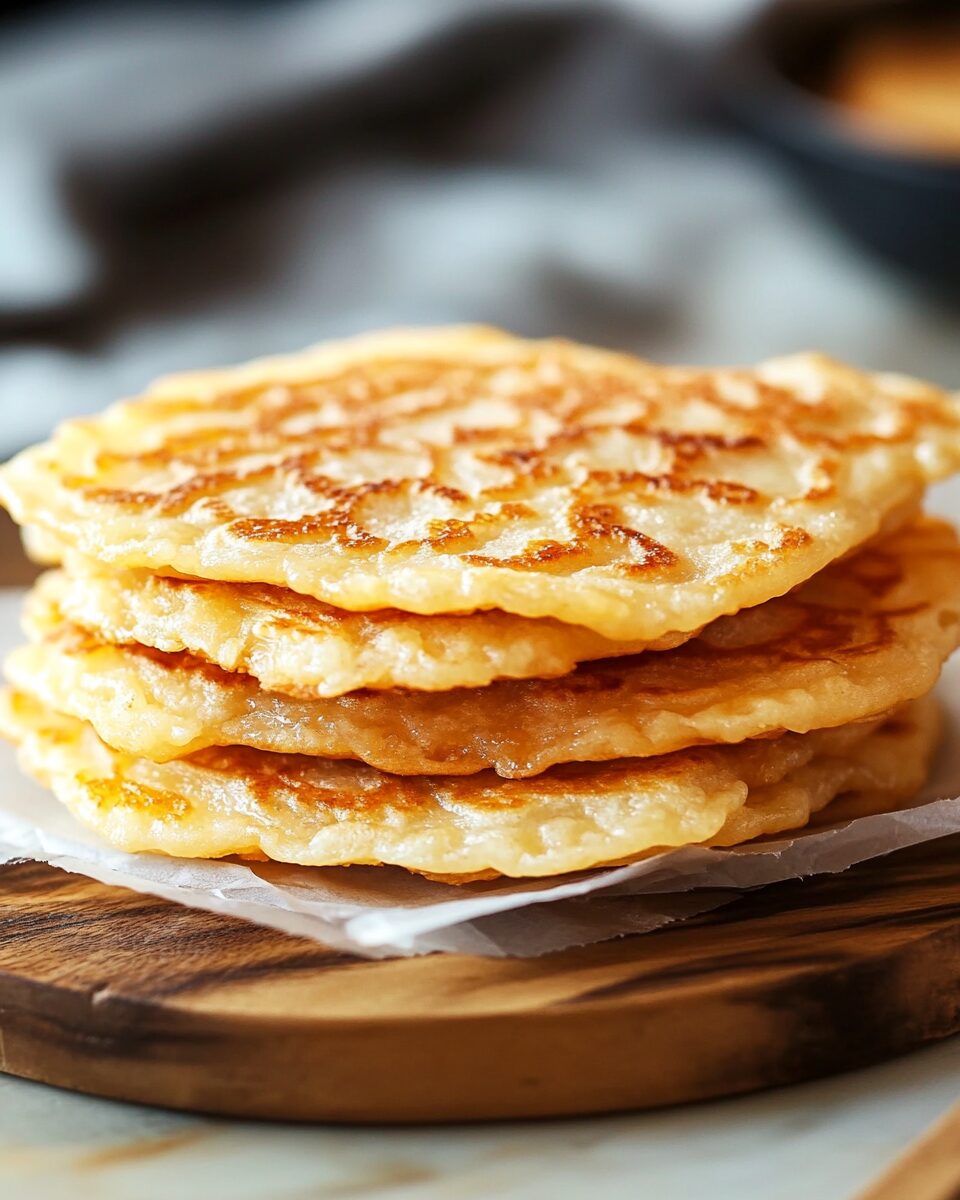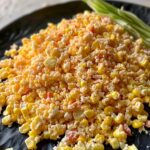Hodduk, also spelled Hotteok, are popular Korean street snacks, especially favored during the winter months. These pan-fried pancakes feature a crispy exterior and a warm, gooey filling made from brown sugar, cinnamon, and nuts.
FULL RECIPE
Ingredients
1.For the dough:
- 1¼ cups (157 g) all-purpose flour
- ½ teaspoon fine sea salt
- 1 teaspoon white sugar
- 1 teaspoon instant dry yeast
- ½ cup (125 ml) lukewarm milk
- 1 tablespoon vegetable oil
2.For the filling:
- ¼ cup dark brown sugar
- ¼ teaspoon ground cinnamon
- 2 tablespoons crushed nuts (walnuts, peanuts, or sunflower seeds)
Directions
- Prepare the Dough: In a bowl, combine the all-purpose flour, salt, sugar, and instant dry yeast. Add the lukewarm milk and vegetable oil. Mix until a sticky dough forms. Cover the bowl and let the dough rest at room temperature for about 20 minutes.
- Prepare the Filling: In a separate bowl, mix together the dark brown sugar, ground cinnamon, and crushed nuts until well combined.
- Shape the Pancakes: After the dough has rested, lightly oil your hands. Divide the dough into 6 equal portions. Flatten each portion into a disk about 3 inches in diameter. Place approximately 1 tablespoon of the filling in the center of each disk. Carefully fold the edges of the dough over the filling, pinching to seal. Gently flatten the filled dough ball into a thick disk.
- Cook the Pancakes: Heat a non-stick skillet or frying pan over medium heat and lightly oil it. Place the filled and flattened dough onto the skillet. Cook for about 2 minutes until the bottom turns golden brown. Flip the pancake and press down gently with a spatula. Cook for another 2 minutes until the other side is also golden brown. Remove from the skillet and repeat with the remaining dough and filling.
- Serve: Enjoy the Hodduk warm, allowing the sweet filling to cool slightly before biting into them.
Nutritional Information
- Calories: 200 kcal
- Carbohydrates: 45 g
- Protein: 4 g
- Fat: 5 g
- Fiber: 2 g
- Sugar: 15 g
The History and Origins of Hodduk
Hodduk, or Hotteok, is a beloved street food that traces its roots to Korea. Its warm, sweet filling and crispy exterior make it a winter favorite. Although the exact origins are debated, it’s believed that Hodduk was influenced by Chinese pancakes brought to Korea in the 19th century. Over time, the dish evolved to suit Korean tastes, with cinnamon, brown sugar, and nuts becoming the signature filling. Today, it’s a common sight on street corners during the winter months.
Hodduk’s Cultural Significance in Korean Cuisine
In Korean culture, food is much more than just nourishment—it’s a way of expressing warmth and togetherness. Hodduk is often seen as a comfort food, particularly enjoyed during the colder seasons. Whether it’s at family gatherings or local festivals, the warm, sugary treat brings people together. Its widespread popularity in Korea during the winter months has turned it into a symbol of community and tradition.
Exploring Popular Variations of Hodduk
While the traditional Hodduk is made with a simple mixture of cinnamon, brown sugar, and crushed nuts, the dish has inspired many regional variations. In some areas, the filling includes honey, seeds, or even chocolate, offering a different spin on the classic. Some recipes also swap out ingredients in the dough itself, such as adding sweet potato or rice flour for gluten-free versions. These changes demonstrate the dish’s adaptability while maintaining its rich, sweet flavor.
Modern Trends in Hodduk
Though Hodduk has maintained its traditional form, recent innovations have made the dish even more exciting. The classic sweet filling has been swapped for savory versions, such as ones with kimchi or vegetables. Additionally, some recipes use gluten-free flour or other alternative ingredients to cater to those with dietary restrictions. These modern twists have broadened the appeal of Hodduk, allowing it to reach a global audience and adapt to changing tastes.
Why Hodduk is a Perfect Winter Treat
There’s something undeniably comforting about the combination of warm dough and gooey sugar filling. This is especially true when the temperatures drop and all you want is something indulgent to enjoy. Hodduk’s crisp exterior and soft, sweet center make it a perfect treat for cold weather. The warmth of the pancakes provides a cozy, comforting feeling, making it the ultimate winter snack.
Making Hodduk at Home
Creating Hodduk at home can be a rewarding experience. While the dough does require time to rise, the process is relatively simple. Homemade Hodduk offers a more personalized touch compared to store-bought versions. Not only can you customize the filling to suit your preferences, but you can also control the ingredients to ensure they meet dietary needs. The smell of fresh Hodduk cooking on your stovetop is an experience in itself!
The Cultural Importance of Hodduk in Korea
In Korea, food plays an essential role in cultural celebrations. Hodduk, in particular, holds significance during the winter months, especially around the Korean New Year. The dish’s rich, warm filling is thought to symbolize prosperity and good fortune for the coming year. For many Koreans, Hodduk is more than just a snack—it’s a tradition that brings families together and creates lasting memories.
The Sweet and Savory Harmony of Hodduk
One of the main reasons Hodduk is so beloved is its balance of flavors. The sweetness of the cinnamon and brown sugar perfectly complements the slightly savory taste of the nuts. The dough itself provides a satisfying contrast, with its crispy texture on the outside and soft, chewy interior. This combination of sweet and savory elements creates a harmony that’s hard to resist, making each bite an enjoyable experience.
Health Benefits of Hodduk
While Hodduk is a treat best enjoyed in moderation, it does offer some health benefits. The nuts in the filling provide a healthy dose of fats, protein, and essential vitamins. Cinnamon, a key ingredient in the filling, is known for its antioxidant properties and potential to help regulate blood sugar levels. However, due to its sugar content, Hodduk should be enjoyed as an occasional indulgence rather than a regular snack.
Gluten-Free Hodduk Options
For those with gluten sensitivities or those following a gluten-free diet, Hodduk can be easily adapted. By using gluten-free flour blends or rice flour, you can create a dough that is just as delicious as the traditional version. These substitutes ensure that the signature texture of the dough is maintained, making gluten-free Hodduk a satisfying alternative. With a few simple swaps, everyone can enjoy this delicious treat without worrying about gluten.
Street Food and Korean Culture
Korean street food is an essential part of the nation’s culinary culture, and Hodduk is one of its most iconic offerings. Street vendors are a common sight in cities like Seoul, where they serve a wide variety of dishes to locals and tourists alike. The appeal of street food lies in its accessibility, affordability, and authenticity. Hodduk, with its comforting warmth, is the perfect snack to enjoy on a chilly winter day, often found in bustling markets and busy streets.
Pairing Suggestions for Hodduk
While Hodduk is delicious on its own, it can also be paired with a variety of beverages to enhance the overall experience. A warm cup of green tea or barley tea complements the sweetness of the pancake, creating a balanced flavor profile. For a more indulgent twist, you could enjoy Hodduk with a scoop of vanilla ice cream or a drizzle of honey. For those looking for a savory balance, pairing Hodduk with a side of spicy kimchi offers a contrast that enhances the overall meal.
The Global Popularity of Hodduk
Though Hodduk originated in Korea, it has gained popularity worldwide. In countries with large Korean communities, like the United States and Canada, you can often find street vendors or restaurants serving this delicious treat. As Korean food continues to gain recognition around the globe, dishes like Hodduk are becoming more accessible. This international reach has introduced many new people to the delights of Korean street food, making Hodduk a favorite among food lovers worldwide.
Hodduk as a Seasonal Tradition
In Korea, many dishes are closely associated with specific seasons, and Hodduk is no exception. It is particularly beloved in the winter, where it can be found at various festivals, markets, and street corners. Its warm, sugary filling makes it the perfect antidote to the chill of winter. For Koreans, Hodduk evokes feelings of nostalgia and togetherness, often enjoyed with family or friends during festive occasions.
Adapting Hodduk for Different Dietary Needs
One of the reasons Hodduk has maintained its popularity is its versatility. You can easily make the dish suit various dietary needs by adjusting the ingredients. For instance, the filling can be made with natural sweeteners like maple syrup or agave nectar instead of sugar. Those following a vegan diet can replace dairy products with plant-based alternatives. These simple changes ensure that Hodduk can be enjoyed by almost anyone, regardless of dietary restrictions.
Making Hodduk a Family Activity
Making Hodduk at home is not just about the final product—it’s also about the process. It’s a fun activity that can be enjoyed by people of all ages. Kids and adults alike can get involved by shaping the dough and filling it with the sweet ingredients. This makes Hodduk an ideal recipe for a family cooking session. It’s an enjoyable way to spend time together, and the end result is a batch of warm, delicious pancakes to share.
The Growing Influence of Korean Food
In recent years, Korean cuisine has been experiencing a surge in popularity around the world. With dishes like bibimbap, bulgogi, and Hodduk gaining global recognition, the influence of Korean food is stronger than ever. This growing interest has been fueled by the rise of K-pop culture and Korean films, which have introduced more people to the unique flavors of Korea. As a result, Korean food is becoming an integral part of the global culinary landscape.
Conclusion
Hodduk is a comforting and delicious treat that has stood the test of time. Its perfect balance of sweet and savory flavors, combined with its crispy, golden exterior, make it a treat worth savoring. Whether you’re enjoying it in Korea or trying it for the first time in your own kitchen, Hodduk is a dish that brings people together. Its versatility, cultural significance, and delicious taste ensure that it will remain a beloved part of Korean cuisine for generations to come.






